Essen
![]()
This article is about the city of Essen in the Ruhr area. For other meanings, see Essen (disambiguation).
Essen is a major city in the centre of the Ruhr area and the Rhine-Ruhr metropolitan region. After Cologne, Düsseldorf and Dortmund, Essen is the fourth largest city in the state of North Rhine-Westphalia and one of the regional centres. With its 591,032 inhabitants (as of 31 December 2020), the independent city in the administrative district of Düsseldorf is one of the ten largest cities in Germany. As an important industrial and business location, Essen is home to well-known major companies and, with the University of Duisburg-Essen, is also a university location. In 1958, the city became the seat of the newly founded diocese of Essen.
The city on the Ruhr, which dates back to the Frauenstift Essen founded 850 years ago, is a member of the Landschaftsverband Rheinland and the headquarters of the Regionalverband Ruhr. As part of the RUHR.2010 - European Capital of Culture project, Essen was the European Capital of Culture in 2010, representing the entire Ruhr region. Due to its central location in the Ruhr region, Essen is also regarded as the "secret capital of the Ruhr region".
Alongside Essen Abbey, Werden Monastery, founded by Liudger around 800, was a centre of late antique-early Christian textual tradition. Elevated to the status of a free imperial city by Emperor Charles IV in the 14th century, Essen had been an armoury since the late Middle Ages and, with industrialisation, rose to become one of the most important centres of the coal and steel industry in Germany (with its own Kux exchange). After a massive decline in heavy industry from the mid-1960s, Essen developed a strong service sector in the course of structural change. Today, Essen Minster and the oldest preserved full-sculpture statue of the Virgin Mary in the Christian West (Golden Madonna) are reminders of the city's medieval history. At the same time, monuments of industrial culture bear witness to its heavy industrial past, especially the UNESCO World Heritage Zollverein Coal Mine. The cityscape is also characterised by striking high-rise buildings.
With the Museum Folkwang, Essen has a renowned collection of modern paintings, sculptures, graphics and photographs. The Opera House, built according to plans by Alvar Aalto, the Folkwang University of the Arts, the Grillo Theatre or the German Poster Museum are prestigious art and cultural institutions.
After Essen was European Capital of Culture in 2010, it was awarded the title of European Green Capital for 2017.
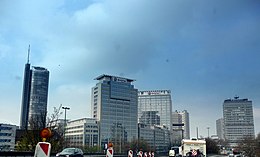
Essen skyline
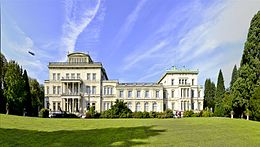
Villa Hügel; symbol of the Krupp family dynasty and industrialisation, as well as a landmark of the city of Essen
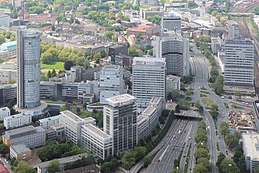
Southern quarter in Essen's city centre dominated by high-rise buildings
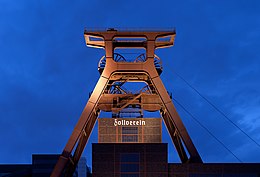
Landmark of the city of Essen: Zollverein Colliery
Geography

enlarge and show information about the picture
![]()
View of Essen from the direction of Mülheim-Heißen
· 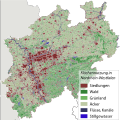
Eating in the Rhine-Ruhr conurbation
· 
Baldeneysee
· 
Ruhr in Kettwig
·
Brehminsel in Essen-Werden
· 
Stone with information board, highest elevation in Essen
Spatial position
Essen is located in the centre of the Ruhr area, for the most part north of the Ruhr, which forms the Baldeneysee, dammed up between the districts of Kupferdreh, Heisingen, Fischlaken and Werden, among others.
Essen is located in the Rhine-Ruhr metropolitan region, an economic region and urban agglomeration in western Germany. The region is one of the largest conurbations within the European megalopolis, making it the largest metropolitan area in Germany. Around eleven million inhabitants live in the region's 20 independent cities and ten districts on an area of just under 10,000 km² (as of 2005). About nine million people live within a radius of 50 kilometres of Essen. Essen is one of the four major centres of the Ruhr area, along with Dortmund, Duisburg and Bochum.
The average altitude of the city is 116 m above sea level. The highest elevation of the city area is in Heidhausen and is 202.5 m above sea level, the lowest point in Karnap measures 26.5 m above sea level. The geographical centre of Essen is in Rüttenscheid in the area of Müller-Breslau-Straße and Wittenbergstraße. The city's location on the northern border of the low mountain ranges determines the geographical layout of Essen and the entire Ruhr area, which has a clear east-west extension between the Ruhr valley in the south via the Hellwee plain to the Emscher valley in the north. The two rivers Ruhr and Emscher, running from east to west, give the landscape its own character. The Ruhr, coming from the Sauerland, winds around the hills of the southern parts of the city and forms alluvial landscapes as well as the reservoirs Baldeneysee and Kettwiger See. The Emscher in the north and, parallel to it, the Rhine-Herne Canal run dead straight through the urban area and, like the Ruhr, flow into the Rhine at Duisburg.
The largest extension of the city area is 21 kilometers in the north-south direction and 17 kilometers in the west-east direction. The length of the city boundary is 87 kilometers.
Waters
Throughout the city there are streams with a length of around 275 kilometres. The best-known bodies of water include the Emscher and the Rhine-Herne Canal in the north and the Ruhr with Lake Baldeney and Lake Kettwig in the south of the city.
In the north of the city are the streams, which are characterised by industrialisation. Many of the streams are used for wastewater disposal, but they are gradually being restored to a near-natural state in the course of the Emscher renaturation by the Emschergenossenschaft. The renaturation will enhance the environment of the streams. These creeks include the Borbecker Mühlenbach, the Berne, the Stoppenberger Bach and the Schwarzbach. The streams that have retained their near-natural state include the Hexbach, the Barchembach and the Schönebecke.
In the south of the city, the Ruhr and near-natural streams flow, many of which are incorporated into landscape conservation areas. The larger ones include the Hesperbach and the Deilbach, smaller ones are the Oefter Bach, the Schuirbach and the Wolfsbach.
City breakdown
The city of Essen consists of nine boroughs. In each district there is a district council with 19 members. The chairman of the district representation is the district mayor. The city districts are identified with Roman numerals and with a special name, which sometimes also consists of several district names.
The nine boroughs are divided into a total of 50 districts. Most of the districts were once independent municipalities and lost their independence through incorporation. The districts are identified with a two-digit Arabic number.
Due to its natural structure, Essen's cityscape is clearly divided into two parts: the densely populated northern districts and the areas around the city centre on the one hand, and the southern part, which is characterised by extensive green spaces and rather small-scale development, on the other.
See also: List of boroughs and districts of Essen
Neighboring cities
The following cities border Essen (clockwise from the east):
 Bochum
Bochum Hattingen (Ennepe-Ruhr district)
Hattingen (Ennepe-Ruhr district) Velbert (district of Mettmann)
Velbert (district of Mettmann) Heiligenhaus (Mettmann district)
Heiligenhaus (Mettmann district) Ratingen (Mettmann district)
Ratingen (Mettmann district) Mülheim an der Ruhr
Mülheim an der Ruhr Oberhausen
Oberhausen Bottrop
Bottrop Gladbeck (Recklinghausen district)
Gladbeck (Recklinghausen district) Gelsenkirchen
Gelsenkirchen
Climate
The average annual temperature in Essen is 11.3 °C. The coldest month is January with 3.4 °C, the warmest is July with 19.7 °C. The amount of precipitation is 866 millimeters per year, with the most precipitation, with 93 millimeters, falling in December.
| Food | ||||||||||||||||||||||||||||||||||||||||||||||||
| Climate diagram | ||||||||||||||||||||||||||||||||||||||||||||||||
| ||||||||||||||||||||||||||||||||||||||||||||||||
| Monthly average temperatures and precipitation for Essen
Source: DWD, Data: 2015-2020 wetterkontor.de, | |||||||||||||||||||||||||||||||||||||||||||||||||||||||||||||||||||||||||||||||||||||||||||||||||||||||||||||||||||||||||||||||||||||||||||||||||||||||||||||||||||||||||||||||||||||||||||||||||||||||||||||||||||||||||||||||||||||||||||||||||||||||||||||||||||||||||||

Map of city districts/boroughs

The Essen skyline by night
Culture
See also: List of sights in Essen and List of works of art in public spaces in Essen
Philharmonic, Opera and Theatre
Essen has in the Theater und Philharmonie Essen (TuP) - organised under a single roof - a philharmonic orchestra with the Saalbau (as a performance venue), an opera house (Aalto-Theater) and a municipal theatre (Grillo-Theater) with several smaller stages attached. The venues of the TUP are among the architectural icons of the region. Over several hundred thousand guests visit the more than 1000 events of the TuP each season.
The Theater im Rathaus is located on the ground floor of the town hall. In the playbill, the range of genres extends from boulevard comedy to thrillers, operettas and musicals to classical drama.
The Stratmanns Theater is located in the Europahaus at Kennedyplatz. Since July 1995 Ludger Stratmann has been performing on his own stage with various cabaret programmes under the motto Doktor Stratmanns - Heiteres Medizinisches Kabarett.
Furthermore, the oldest private theatre in North Rhine-Westphalia (Das Kleine Theater Essen), a boulevard theatre and the GOP Varieté Essen exist in Essen. The Colosseum Theater has served as an event hall since 2010, mainly for dance and music shows.
Museums
The Zeche Zollverein as the landmark of Essen houses several museums and places worth seeing. Like no other, the Ruhr Museum stands for Ruhr culture. It occupies the largest part of the colliery and shows the past, present and future of the mining region.
Zeche Zollverein is also home to the Red Dot Design Museum, which shows the largest design exhibition worldwide. Less art in the narrower sense is exhibited in the boiler house of the Zeche Zollverein - the focus here is on functional design. Mainly objects of daily use are on display, from cutlery and kitchen fittings to furniture, office equipment and various cars.
The Museum Folkwang is located in the district of Rüttenscheid. The art museum houses a large collection of important paintings, sculptures and graphics by world-famous artists as well as an important photo collection. The new building on Museumsplatz also houses the German Poster Museum.
In addition to the large, well-known museums, Essen also has a number of other museums to offer. The Essen Cathedral Treasury is one of the most important collections of ecclesiastical works of art in Germany. In the Grugapark, over 40 sculptures and works of art are currently on display spread across the open area. They range from classical modern to contemporary art and can be viewed on guided tours, among other things. An ensemble of contemporary sculptures can be found on Moltkeplatz in the Moltkeviertel.
See also: List of museums in Essen
Historical societies
Founded in 1880, the Historischer Verein für Stadt und Stift Essen e. V. is one of the oldest historical societies in Germany.
A large number of Essen citizens are involved in the history of the city of Essen and its districts on a full-time or voluntary basis. Most of them have joined forces to form the Essen History Initiatives Working Group.
Cinema
Essen's cinema landscape consists of several locations: The Lichtburg, built in 1928 and restored in 2003, is located on Kettwiger Straße; there is also the multiplex Cinemaxx, which opened on Berliner Platz in 1991, as well as several art house cinemas. The Lichtburg has 1250 seats and is the largest cinema in Germany. Film premieres and galas are held here at regular intervals. The Cinemaxx cinema centre is the largest multiplex cinema in Germany with 16 cinema halls and a total of 5354 seats. Due to the triumph of the television set, around ⅔ of all cinemas closed in the 1960s and 1970s in Essen alone. After the Cinemaxx opened, the attendance figures of the other cinemas in Essen slumped again and most of them were closed. In Essen's city centre alone, more than ten cinemas fell victim to the Cinemaxx. The majority of the closed cinemas were converted into shops, some also into discotheques and clubs. Some former cinemas are still empty today. Only the Lichtburg and four Essen art house cinemas were able to hold their own against the multiplex cinema. The Filmtheater Astra in Teichstraße is the largest art-house cinema in the Ruhr area. It has room for 430 spectators. The small cinema Luna in the same building complex has 80 seats. The Eulenspiegel cinema on Steeler Straße, which opened in 1955, has been one of Essen's art-house cinemas since 1980. A special feature is a Wurlitzer silent film organ in the cinema hall and the associated cinema museum. The Glückauf film studio is located in Rüttenscheid. The cinema, located in the Glückaufhaus, is one of the oldest film theatres in the Ruhr area. Also in Rüttenscheid is the Galerie Cinema, the smallest cinema in Essen with 45 seats. Harold and Maude has been shown here weekly since 1975. In the north of the city, at Sulterkamp 70, is the Drive-in Autokino Essen with a capacity of 1000 cars.
Cultural Centers
The Unperfekthaus (also known as UpH for short) is a cultural institution in Essen's city centre. The "artists' village" offers creative and creative people the opportunity to realise themselves on 4000 square metres spread over seven floors. There is no censorship or guidelines of any kind. The only prerequisite is that the activities are legal, creative and open to the public. Other cultural centres are the Zeche Carl in Altenessen, the Grend cultural centre in Steele and the Kunsthaus Essen in Rellinghausen.
Regular events
|
|
On 11 April 2006, the city was chosen by a seven-member EU jury as the European Capital of Culture 2010 on behalf of the entire Ruhr region. Pécs (Hungary) and Istanbul held the title at the same time. Besides Essen, the Regionalverband Ruhr, the state of North Rhine-Westphalia and the Initiativkreis Ruhrgebiet were involved in RUHR.2010.
The Love Parade, formerly held in Berlin, was in Essen at the end of August 2007. From 23 August, many clubs in the region were open for special events, until the event came to an end on 25 August with the actual parade. The parade was led through the northern city centre, the final rally took place on the former fairground at Berliner Platz.
The Essen Light Weeks, which have been held annually since the 1950s, have a motto every decade. From the end of October to the beginning of January of the following year, light installations are set up above the inner city streets of Essen.
The cultural trail of the city of Essen leads visitors to art and cultural places between the Marktkirche and Museum Folkwang.
In many districts of Essen there are local history, civic and tourist associations. 26 such associations have joined together in the "Stadtverband der Bürger- und Verkehrsvereine Essen". Another city federation is the "Stadtverband Essen der Kleingärtnervereine" (Essen federation of allotment garden associations), to which 112 Essen allotment garden associations with a total of 203 allotment garden sites belong in 2020.
Culinary specialities
- Borbeck light steam beer
- Borbecker Schloßtropfen (herbal liqueur)
- Steeler Krieger (herbal liqueur)
- Waddische Appeltate (Werden apple pie)

The Zeche Zollverein is home to the Ruhr Museum and the Red Dot Design Museum
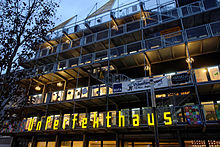
Unperfekthaus
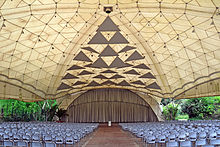
Music pavilion in the Grugapark
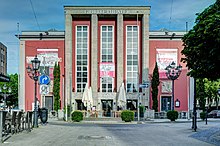
Grillo Theatre

Saalbau, seat of the Philharmonie Essen
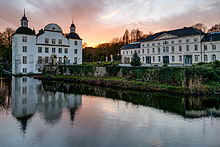
Borbeck Castle as a cultural and meeting place and event venue with permanent historical exhibition
Questions and Answers
Q: What is the pronunciation of Essen?
A: The pronunciation of Essen is [ˈɛsn̩].
Q: What language is spoken in Essen?
A: Low Franconian and Ripuarian are spoken in Essen.
Q: What state is Essen located in?
A: Essen is located in the state of North Rhine-Westphalia.
Q: Where is Essen located relative to other cities?
A: Essen is near Cologne, Duisburg and Bochum.
Q: How many people live in Essen?
A: There are 585,000 inhabitants living in Essen.
Q: How many people live in the Ruhr area including Dortmund and Essen combined?
A: The Ruhr area has a population of 5 million with Dortmund and Essen included.
Q: Why is it called the shopping city?
A: It's called the shopping city because there are so many malls and shops there.
Search within the encyclopedia
